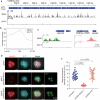A Novel Nuclear Protein Complex Controlling the Expression of Developmentally Regulated Genes in Toxoplasma Gondii
- PMID: 39716984
- PMCID: PMC11831446
- DOI: 10.1002/advs.202412000
A Novel Nuclear Protein Complex Controlling the Expression of Developmentally Regulated Genes in Toxoplasma Gondii
Abstract
Toxoplasma gondii is a ubiquitous protozoan parasite with a complex life cycle containing multiple developmental stages. The parasites have distinct gene expression patterns at different stages to enable stage specific life activities, but the underlying regulatory mechanisms are largely unknown. In this study, a nuclear complex is identified that controls the expression of developmentally regulated genes. This complex consists of the AP2 family transcription factor AP2XII-5, the epigenetic factors MORC and HDAC3, as well as a novel AP2XII-5 interacting protein 1 (AIP1) that stabilizes this complex. At the tachyzoite stage when the parasites proliferate rapidly by asexual endodyogeny, AP2XII-5 binds to the promoter regions of developmentally activated genes and recruits MORC and HDAC3 to suppress their expression. When sexual commitment and merozoite development are triggered, the abundance of AP2XII-5 decreases and its suppression on target genes is relieved. In contrast to MORC and HDAC3, which regulate Toxoplasma development but are also essential for tachyzoite growth, AP2XII-5 and AIP1 are dispensable for tachyzoite proliferation in vitro. These data suggest that while MORC and HDAC3 have broad regulatory activities, forming a complex with AP2XII-5 and AIP1 enables them to specifically regulate gene expression during development.
Keywords: AP2 transcription factor; HDAC3; bradyzoite; epigenetic factor; merozoite.
© 2024 The Author(s). Advanced Science published by Wiley‐VCH GmbH.
Conflict of interest statement
The authors declare no conflict of interest.
Figures








Similar articles
-
AP2XII-1 and AP2XI-2 Suppress Schizogony Gene Expression in Toxoplasma gondii.Int J Mol Sci. 2024 May 18;25(10):5527. doi: 10.3390/ijms25105527. Int J Mol Sci. 2024. PMID: 38791568 Free PMC article.
-
Toxoplasma gondii AP2XII-2 Contributes to Transcriptional Repression for Sexual Commitment.mSphere. 2023 Apr 20;8(2):e0060622. doi: 10.1128/msphere.00606-22. Epub 2023 Feb 14. mSphere. 2023. PMID: 36786611 Free PMC article.
-
Toxoplasma gondii AP2XII-2 Contributes to Proper Progression through S-Phase of the Cell Cycle.mSphere. 2020 Sep 16;5(5):e00542-20. doi: 10.1128/mSphere.00542-20. mSphere. 2020. PMID: 32938695 Free PMC article.
-
Host sensing and signal transduction during Toxoplasma stage conversion.Mol Microbiol. 2021 May;115(5):839-848. doi: 10.1111/mmi.14634. Epub 2020 Nov 21. Mol Microbiol. 2021. PMID: 33118234 Free PMC article. Review.
-
The Epigenome, Cell Cycle, and Development in Toxoplasma.Annu Rev Microbiol. 2018 Sep 8;72:479-499. doi: 10.1146/annurev-micro-090817-062741. Epub 2018 Jun 22. Annu Rev Microbiol. 2018. PMID: 29932347 Review.
References
-
- Lourido S., Trends in parasitology 2019, 35, 944. - PubMed
-
- Dubey J. P., The Journal of eukaryotic microbiology 2008, 55, 467. - PubMed
-
- a) Fritz H., Barr B., Packham A., Melli A., Conrad P. A., Journal of microbiological methods 2012, 88, 47; - PMC - PubMed
- b) Dubey J. P., Frenkel J. K., The Journal of protozoology 1972, 19, 155; - PubMed
- c) Dubey J. P., Veterinary parasitology 2006, 140, 69; - PubMed
- d) Dubey J. P., Frenkel J. K., The Journal of protozoology 1976, 23, 537. - PubMed
MeSH terms
Substances
Grants and funding
- 2022YFD1800200/National Key Research and Development Program of China
- 32273033/National Natural Science Foundation of China
- 2020B0301030007/Guangdong Major Project of Basic and Applied Basic Research
- SZYJY2022015/HZAU-AGIS Cooperation Fund
- 2662023PY005/Fundamental Research Funds for the Central Universities
LinkOut - more resources
Full Text Sources
Research Materials
Miscellaneous
